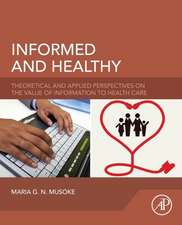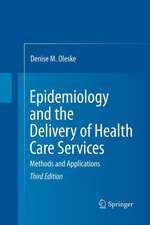Handbook of Biosurveillance
Editat de Michael M. Wagner, Andrew W. Moore, Ron M. Aryelen Limba Engleză Hardback – 9 iul 2006
- Reviews the current mathematical, statistical, and computer science systems for early detection of disease outbreaks
- Provides extensive coverage of existing surveillance data
- Discusses experimental methods for data measurement and evaluation
- Addresses engineering and practical implementation of effective early detection systems
- Includes real case studies
Preț: 811.44 lei
Preț vechi: 1111.56 lei
-27% Nou
Puncte Express: 1217
Preț estimativ în valută:
155.26€ • 162.55$ • 128.47£
155.26€ • 162.55$ • 128.47£
Carte tipărită la comandă
Livrare economică 07-21 aprilie
Preluare comenzi: 021 569.72.76
Specificații
ISBN-13: 9780123693785
ISBN-10: 0123693780
Pagini: 624
Ilustrații: Approx. 150 illustrations (50 in full color)
Dimensiuni: 216 x 279 x 32 mm
Greutate: 1.9 kg
Editura: ELSEVIER SCIENCE
ISBN-10: 0123693780
Pagini: 624
Ilustrații: Approx. 150 illustrations (50 in full color)
Dimensiuni: 216 x 279 x 32 mm
Greutate: 1.9 kg
Editura: ELSEVIER SCIENCE
Public țintă
Public health professionals, medical informaticians, and consultants for biodefense systems. Government health officials and decision-makers involved with public health and bioterrorism response will also find the book of interest.Cuprins
PART I: THE CHALLENGE OF BIOSURVEILLANCE
Chapter 1: Introduction
Chapter 2: Outbreaks and Investigations
Chapter 3: Case Detection, Outbreak Detection, and Outbreak Characterization
Chapter 4: Functional Requirements for Biosurveillance
PART II: ORGANIZATIONS THAT CONDUCT BIOSURVEILLANCE AND THE DATA THEY COLLECT
Chapter 5: Governmental Public Health
Chapter 6: The Healthcare System
Chapter 7: Animal Health
Chapter 8: Laboratories
Chapter 9: Water Suppliers
Chapter 10: Food and Pharmaceutical Industries
Chapter 11: Coroners and Medical Examiners
Chapter 12: Other Organizations That Conduct Biosurveillance
PART III: DATA ANALYSIS
Chapter 13: Case Detection Algorithms
Chapter 14: Classical Time-Series Methods for Biosurveillance
Chapter 15: Combining Multiple Signals for Biosurveillance
Chapter 16: Methods for Detecting Spatial and Spatio-Temporal Clusters
Chapter 17: Natural Language Processing for Biosurveillance
Chapter 18: Bayesian Methods for Diagnosing Outbreaks
Chapter 19: Atmospheric Dispersion Modeling in Biosurveillance
Chapter 20: Methods for Algorithm Evaluation
PART IV: NEWER TYPES OF SURVEILLANCE DATA
Chapter 21: Methods for Evaluating Surveillance Data
Chapter 22: Sales of Over-the-Counter Healthcare Products
Chapter 23: Chief Complaints and ICD Codes
Chapter 24: Absenteeism
Chapter 25: Emergency Call Centers
Chapter 26: The Internet as Sentinel
Chapter 27: Physiologic and Space-Based Sensors
Chapter 28: Data NOS (Not Otherwise Specified)
PART V: DECISION MAKING
Chapter 29: Decision Analysis
Chapter 30: Probabilistic Interpretation of Surveillance Data
Chapter 31: Economic Studies in Biosurveillance
PART VI: BUILDING AND FIELD TESTING BIOSURVEILLANCE SYSTEMS
Chapter 32: Information Technology Standards in Biosurveillance
Chapter 33: Architecture
Chapter 34: Advancing Organizational Integration: Negotiation, Data Use Agreements, Law and Ethics
Chapter 35: Other Design and Implementation Issues
Chapter 36: Project Management
Chapter 37: Methods for Field Testing of Biosurveillance Systems
Epilogue: The Future of Biosurveillance
APPENDICES
CDCâ„¢ Severe Acute Respiratory Syndrome
Sample Questionnaire/Survey
Surveillance Data Tables
Derivation of Bayes’ Rule
Predictive Value Positive and Negative
Data Communication to RODS: Technical Specifications
Data Use Agreement
Department of Health Authorized Use Agreement for Clinical Data
National Retail Data Monitor/RODS Account Access Agreement
Data Security Agreementâ€Personnel
Data Use Agreement with Commercial Data Provider
Glossary
Index
Chapter 1: Introduction
Chapter 2: Outbreaks and Investigations
Chapter 3: Case Detection, Outbreak Detection, and Outbreak Characterization
Chapter 4: Functional Requirements for Biosurveillance
PART II: ORGANIZATIONS THAT CONDUCT BIOSURVEILLANCE AND THE DATA THEY COLLECT
Chapter 5: Governmental Public Health
Chapter 6: The Healthcare System
Chapter 7: Animal Health
Chapter 8: Laboratories
Chapter 9: Water Suppliers
Chapter 10: Food and Pharmaceutical Industries
Chapter 11: Coroners and Medical Examiners
Chapter 12: Other Organizations That Conduct Biosurveillance
PART III: DATA ANALYSIS
Chapter 13: Case Detection Algorithms
Chapter 14: Classical Time-Series Methods for Biosurveillance
Chapter 15: Combining Multiple Signals for Biosurveillance
Chapter 16: Methods for Detecting Spatial and Spatio-Temporal Clusters
Chapter 17: Natural Language Processing for Biosurveillance
Chapter 18: Bayesian Methods for Diagnosing Outbreaks
Chapter 19: Atmospheric Dispersion Modeling in Biosurveillance
Chapter 20: Methods for Algorithm Evaluation
PART IV: NEWER TYPES OF SURVEILLANCE DATA
Chapter 21: Methods for Evaluating Surveillance Data
Chapter 22: Sales of Over-the-Counter Healthcare Products
Chapter 23: Chief Complaints and ICD Codes
Chapter 24: Absenteeism
Chapter 25: Emergency Call Centers
Chapter 26: The Internet as Sentinel
Chapter 27: Physiologic and Space-Based Sensors
Chapter 28: Data NOS (Not Otherwise Specified)
PART V: DECISION MAKING
Chapter 29: Decision Analysis
Chapter 30: Probabilistic Interpretation of Surveillance Data
Chapter 31: Economic Studies in Biosurveillance
PART VI: BUILDING AND FIELD TESTING BIOSURVEILLANCE SYSTEMS
Chapter 32: Information Technology Standards in Biosurveillance
Chapter 33: Architecture
Chapter 34: Advancing Organizational Integration: Negotiation, Data Use Agreements, Law and Ethics
Chapter 35: Other Design and Implementation Issues
Chapter 36: Project Management
Chapter 37: Methods for Field Testing of Biosurveillance Systems
Epilogue: The Future of Biosurveillance
APPENDICES
CDCâ„¢ Severe Acute Respiratory Syndrome
Sample Questionnaire/Survey
Surveillance Data Tables
Derivation of Bayes’ Rule
Predictive Value Positive and Negative
Data Communication to RODS: Technical Specifications
Data Use Agreement
Department of Health Authorized Use Agreement for Clinical Data
National Retail Data Monitor/RODS Account Access Agreement
Data Security Agreementâ€Personnel
Data Use Agreement with Commercial Data Provider
Glossary
Index













